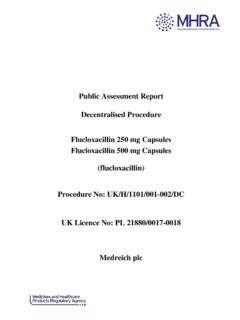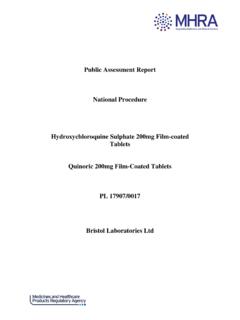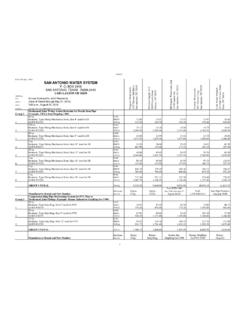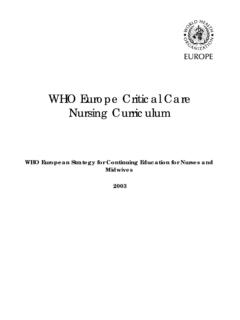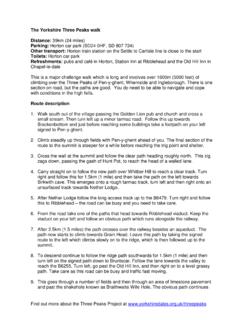Transcription of ISSN 0017-8748 © 2012 American Headache Society …
1 Research SubmissionsThe 2012 AHS/AAN Guidelines for Prevention of EpisodicMigraine: A Summary and Comparison With Other RecentClinical Practice Guidelineshead_2185 Loder, MD, MPH; Rebecca Burch, MD; Paul Rizzoli, MDBackground. Updated guidelines for the preventive treatment of episodic migraine have been issued by the AmericanHeadache Society (AHS) and the American Academy of Neurology (AAN). We summarize key 2012 guideline recommenda-tions and changes from previous guidelines. We review the characteristics, methods, consistency, and quality of the AHS/AANguidelines in comparison with recently issued guidelines from other specialty To accomplish this, we reviewed the AHS/AAN guidelines and identified comparable recent guidelines througha systematic MEDLINE search. We extracted key data, and summarized and compared the key recommendations and assessedquality using the Appraisal of Guidelines Research and Evaluation-II (AGREE-II) tool.
2 We identified 2 additional recentguidelines for migraine prevention from the Canadian Headache Society and the European Federation of NeurologicalSocieties. All of the guidelines used structured methods to locate evidence and linked recommendations with assessment of theevidence, but they varied in the methods used to derive recommendations from that Overall, the 3 guidelines were consistent in their recommendations of treatments for first-line use. All ratedtopiramate, divalproex/sodium valproate, propranolol, and metoprolol as having the highest level of evidence. In contrast,recommendations diverged substantially for gabapentin and feverfew. The overall quality of the guidelines ranged from 2 to 6out of 7 on the AGREE-II The AHS/AAN and Canadian guidelines are recommended for use on the basis of the AGREE-II qualityassessment. Recommendations for the future development of clinical practice guidelines in migraine are provided.
3 In particular,efforts should be made to ensure that guidelines are regularly updated and that guideline developers strive to locate andincorporate unpublished clinical trial words: migraine, guidelines, prevention, prophylaxis, quality, AGREE-II(Headache2012;52:930-945)INTRODU CTIONThe American Headache Society (AHS) and theAmericanAcademy of Neurology (AAN) have issuedupdated guidelines for pharmacologic preventivetreatment of episodic ,2 Migraine is acommon, disabling, and costly disorder. There isno cure, but preventive treatment to decrease thenumber and severity of Headache attacks improveshealth outcomes and quality of also reducesdisability and the Graham Headache Center and the Department ofNeurology, Division of Headache and Pain, Brigham andWomen s and Faulkner Hospitals, Boston, MA, USA ( , R. Burch, P. Rizzoli).Address all correspondence to E. Loder, Department of Neu-rology, Brigham and Women s Hospital, 1153 Centre Street,Boston, MA 02130, USA, email: download a podcast featuring further discussion of thisarticle, please visit for publication April 23, of Interest:PR and RB have no conflicts of interestrelevant to this paper.
4 EL is a member of the disseminationcommittee for the 2012 AHS/AAN Guidelines but was notinvolved in their development. She is the president-elect ofthe American Headache Society , which was a partner in thedevelopment of the guidelines and endorsed the support for work: 0017 -8748doi: by Wiley Periodicals, 2012 American Headache Society930 The AHS/AAN guidelines are the result of asystematic search, expert review, and synthesis of rel-evant evidence for preventive treatments of episodicmigraine. The evidence identified in formulating theprevious guidelines in 2000 was supplemented withevidence from a new search that extended throughmid the availability of such up-to-date,evidence-based recommendations, research suggeststhat a majority of migraine sufferers who wouldbenefit from prevention therapies do not ,6 Possible barriers to the adequate preventivetreatment of migraine may be lack of physicianawareness of the contents of clinical practice guide-lines or a lack of confidence in the methodology andquality of such in guidelinequality and consistency has been demonstrated inother therapeutic recent study on clini-cal practice guideline quality concluded that thequality of clinical practice guidelines improved onlyslightly over the past 2 sought to summarize the key recommenda-tions of the 2012 AHS/AAN guidelines and identifyareas of change from the 2000 guidelines that theyreplace.
5 In addition, we systematically review thequality and consistency of these guidelines in com-parison with 2 other recent migraine preventionclinical practice authors read the 2012 AHS/AAN guidelinesfor migraine prevention, and EL summarized keyconcepts and changes from the 2000 reviewed with PR and RB, and agreement onthe summary was reached by consensus. Althoughthese guidelines were published as 2 separate papers,1 covering traditional pharmacologic agents formigraine prophylaxis and the other coveringnon-steroidal anti-inflammatory drugs (NSAIDs),complementary treatments and other miscellaneoustreatments, for the purposes of this review, weconsider the guidelines as a whole and refer to thecontents of the 2 documents as the AHS/AANguidelines. Although the 2012 guidelines incorporatedrugs used for short-term prophylaxis of menstruallytriggered migraine attacks among the other treat-ments, for this review, we consider them separately tofacilitate comparison with other guidelines, whichgenerally do not consider such short-term treatmentsto be comparable with daily, long-duration additional caveat, conspicuous by its absencefrom the guidelines presented here is onabotulinum-toxinA.
6 OnabotulinumtoxinA has been extensivelystudied for treatment of episodic migraine and foundto be ineffective. It was not included in the currentAHS/AAN guidelines for preventive treatment ofepisodic migraine because it is covered in anotherAAN guideline, where it is identified as ineffectivefor episodic migraine. OnabotulinumtoxinA was,however,approved by the Food and DrugAdministra-tion for the treatment ofchronicmigraine in October2010, and at this writing is the only treatment specifi-cally indicated for that migraine variant. Its exclusionreflects simply that the guidelines we review and sum-marize pertain to the treatment ofepisodicmigraine(ie, migraine with a Headache burden of<15 days/month).A discussion ofchronicmigraine and its treat-ment would be timely (and clinically relevant) but liesbeyond the scope of the present the systematic review portion of this study,wesearched for clinical practice guidelines for the pre-ventive treatment of migraine in adults 18 or included only guidelines based on a systematicreview and synthesis of evidence, and graded recom-mendations linked to evidence quality.
7 Guidelineshad to be written in English and endorsed by anational or international professional excluded guidelines that focused solely on thetreatment of specific subgroups of migraineurs,eg, pregnant women or children. To ensure that theclinical practice guidelines included in this review arerelevant to contemporary medical practice, inclusionwas limited to guidelines published from January2008 through April searched MEDLINE from January 2008 toApril 2012 using the text words and Medical SubjectHeading terms of migraine and guidelines. Theelectronic database search was supplemented bysearching websites that list guidelines. The searchstrategy is contained in Appendix II. EL screened thesearch results for inclusion. Full-text papers wereHeadache931retrieved for potentially relevant clinical practiceguidelines and reviewed against inclusion included clinical practice guidelines were sum-marized descriptively by EL and reviewed by RBaccording to pharmacologic and other preventivetreatment options.
8 For each treatment, we notedwhether the respective guideline recommendedthat treatment, the level of evidence assigned to it,and the appraised quality of studies supporting compared treatment ratings among theincluded guidelines. Because each guideline used dif-ferent methods to rate and assign treatments to cat-egories, we assumed that the top tier in each ratingsystem was comparable with the top tier in the otherguidelines, and so , Level A in the AHS/AANguidelines was considered equivalent to the High level of evidence category in the Canadian guidelines(regardless of the strength of the recommendation touse or not use, which was based on judgments aboutthe balance of harms to benefits) and the drugs offirst choice category in European Federation of Neu-rological Societies (EFNS). Similarly, Level B wasconsidered equivalent to the Moderate level of evi-dence category in the Canadian guidelines and the drugs of second choice category in the EFNS ,Level C in theAHS/AAN guidelines wasconsidered equivalent to the Low level of evidencecategory in the Canadian guidelines and to the drugsof third choice category in the EFNS authors independently scored retrievedguidelines according to the Appraisal of Guidelinesfor Research and Evaluation (AGREE) II AGREE criteria are widely used to assess thequality of clinical practice guidelines.
9 They provide alist of specific information that should be reportedin guideline publications. Specifically, the AGREE-IIassessment instrument contains 23 items distributedamong 6 quality domains, along with 2 global 6 domains and the guideline characteristicsassessed within each domain are: (1) Scope andPurpose, which assesses the overall aim of the guide-line and target groups for whom the guideline isintended; (2) Stakeholder Involvement, which evalu-ates the extent to which appropriate stakeholderswere involved in developing the guideline andwhether it represents the views of its intended users;(3) Rigor of Development, which appraises theprocess of gathering and summarizing the evidenceand methods used to develop recommendations; (4)Clarity of Presentation, which evaluates the language,structure, and format of the guideline; (5) Applicabil-ity, which evaluates potential barriers and facilitatorsto implementation and strategies to improve uptakeas well as resources needed to implement the guide-line.
10 And (6) Editorial Independence, which evaluatesbiases because of competing interests. The overallassessment includes rating the overall quality of theguideline and stating whether the guideline is recom-mended for use in item within a domain is rated on a 7-pointscale ranging from 1 (strongly disagree) to 7 (stronglyagree). A score of 1 indicates that there is no infor-mation on that item or that it is very poorly score of 7 indicates that criteria for the item delin-eated in the AGREE-II user manual have been metand that the reporting is complete and qualityscore for each of the 6 domains is calculated, inaddition to a global assessment of overall guidelinequality and recommendations for clinical use. TheAGREE-II developers recommend that guidelinequality should be assessed by 2-4 of AHS/AAN Migraine PreventionGuideline Recommendations. Tables 1 3 summa-rize key recommendations of the AHS/AAN 2012guidelines for preventive treatment of migraine.

